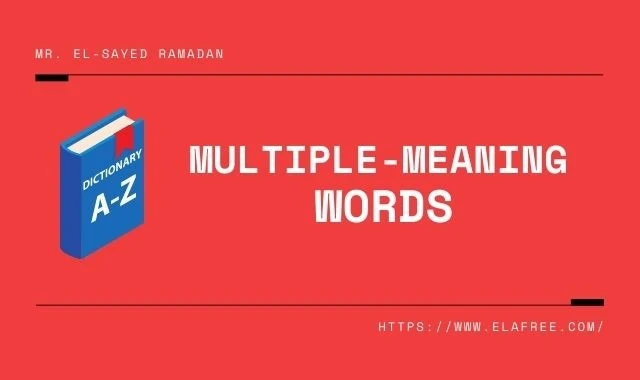Multiple-Meaning Words
In this lesson, you will focus on the following objective: Understanding multiple-meaning words.
Multiple-Meaning Words
Vocabulary Term
A multiple-meaning word is a word that has two or more meanings.
Literature Connection
The second sentence in this quotation includes two multiple-meaning words.
“She sat on the opposite seat, away from the window, facing her mother. They were both in severe and poor mourning clothes.”
—Gabriel García Márquez, from “Tuesday Siesta”
Severe can mean either “plain” or “harshly judgmental”; and poor can mean “pitiable,” “humble,” or “poverty-stricken.” From the context, the surrounding text, readers conclude that the women’s clothes were plain and humble.
Examples
| Word | Meaning | Example |
|---|---|---|
| plain | n. flat, treeless land adj. simple and unadorned adj. evident |
The plain stretched, unbroken, into the distance. They were plain and simple people. The priest’s embarrassment was plain to them. |
| still | adv. yet adj. quiet and unmoving v. to calm |
They still had not reached the station. During the siesta, the whole town was still. The rabbi stilled the woman’s fears. |
| train | n. connected line of railroad cars n. trailing part of a dress v. to teach or instruct |
The woman took a train to visit her aunt. The bride’s gown had a long, intricate train. She trained her puppy to be obedient. |
Multiple-Meaning Words Quiz
Choose the correct definition for the multiple-meaning word in each sentence. Consult a dictionary if you need help.
FAQs
Q: What are multiple-meaning words?
A: Multiple-meaning words are words that have more than one meaning. For example, the word "bank" can refer to a financial institution or the land alongside a river or lake.
Q: How do multiple-meaning words develop?
A: Multiple-meaning words develop when a word is used in different contexts over time and takes on different meanings. This process is called semantic change or semantic shift.
Q: How can multiple-meaning words cause confusion?
A: Multiple-meaning words can cause confusion in communication if the speaker and listener interpret the word differently based on its context. Clarification may be needed to understand the intended meaning.
Q: What are some common examples of multiple-meaning words?
A: Common multiple-meaning words include bat (animal or baseball bat), duck (bird or to duck down), pound (unit of weight or pound on the door), and jam (fruit spread or traffic jam). Homonyms like to, two, and too are also examples.
Q: How can multiple-meaning words be used effectively?
A: Writers can use multiple-meaning words intentionally to create puns or double entendres. Careful context clues help readers discern the intended meaning. Understanding multiple meanings improves vocabulary and reading comprehension.
References
- Miller, George A. "WordNet: An Electronic Lexical Database." Communications of the ACM 38.11 (1995): 39-41.
- Palmer, Frank R. Semantics: A New Outline. Cambridge University Press, 76 (1995).
- Katz, Jerrold J. "Semantic Theory and the Meaning of Good." Journal of Philosophy 64.23 (1967): 739-766.

